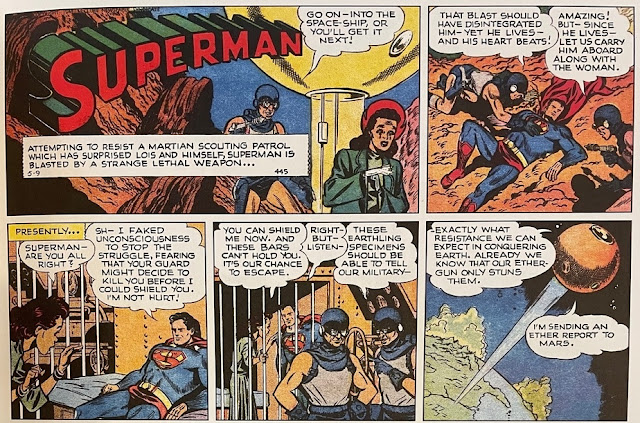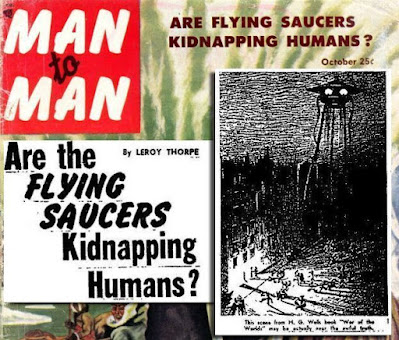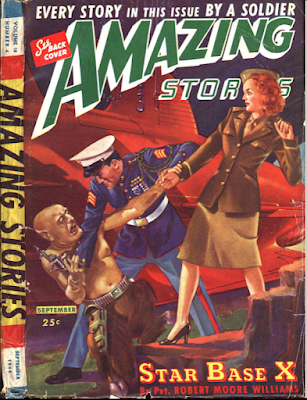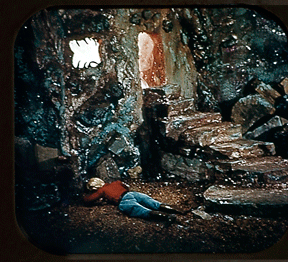Notions of alien abductions were circulating long before the 1961 Betty and Barney Hill case, even before anyone had heard of flying saucers. Charles Fort’s 1919, The Book of the Damned discussed the possibility of extraterrestrial visitors, and he speculated that someone up there likes us - as in the way we taste.
“And I have data that, in this book, I can't take up at all — mysterious disappearances. I think we're fished for.”The Fortean journal, Doubt # 13, 1945 had a short article that played off this notion, supposing that the missing crew of a German ship might have become a meal for Martians.
 |
| “Earth Slaves to Space” by Richard Shaver, Amazing Stories Sept. 1946 |
Ray Palmer published the stories of Richard Shaver as nonfiction as in Amazing Stories, tales of an ancient extraterrestrials, the Atlans and Titans. Carrying a cover date of June 1947 but published at least a month earlier, Palmer put out a special all-Shaver Mystery issue, and his editorial stated:
“…Mr. Shaver declared that Titans, living far away in space, or other people like them, still visit earth in space ships, kidnap people, raid the caves for valuable equipment, and, in general, supply the basis for all the weird stories that are so numerous (see Charles Fort's books) of space ships, beings in the sky, etc.”
More seriously, John W. Campbell's editorial in the October 1947 issue of Astounding Science Fiction was titled, “Flying Somethings,” where he speculated that UFOs were extraterrestrial scout vehicles, and he discussed how they might abduct specimens for study. He wrote about it from flipped point of view, as if we were the explorers of another planet:
"For several months, our investigation would be conducted by noncontact observation; until we know much more about the people, we'll do well to stay clear of them. After some weeks though, a stealthy raid might kidnap a few inhabitants for general questioning and investigation. In this, we'd be very smart not to damage the kidnaped parties; the resentment of a technically civilized race can be distinctly unwelcome even to a more powerfully technical people. Investigation of local animals can give all the necessary basic biological science for preliminary understanding of the local race.”(See pages 71-72 of this PDF for Campbell's full article: UFOs: A History, Supplemental Notes August 1—December 31 by Loren E. Gross.)
Comics are often a good indicator of how a topic has penetrated the public’s consciousness, but occasionally they have been ahead of trends. An alien abduction kicked off the story in the Sunday Superman newspaper comic strip from May 2 to July 18, 1948. Superman and Lois Lane were captured by a scouting party for invaders from Mars and taken aboard their spherical Martian spaceship.
 |
| (Reprinted in Superman: The Golden Age Sundays 1946–1949 by IDW Publishing, 2014.) |
"Have you thought how many unsolved disappearances are explained by the 'specimens' of human beings that they have taken for study?"
 |
The Honolulu Star-Bulletin, Oct.
4, 1952 |
The notion of flying saucer abductions came up now and then, but not in reputable places. The October 1953 issue of Man to Man magazine featured the article by Leroy Thorp, “Are the Flying Saucers Kidnapping Humans?” It was not based on contemporary accounts, just an undated recycling of a mysterious disappearance supposedly taken from one of Charles Fort’s books.
Harold T. Wilkins wrote a book released in the U.S. as Flying Saucers on the Attack in July 1954. It included several stories about the unexplained loss of people, planes, and ships, and he suggested alien abduction as the solution:
“One wonders how many cases of mysterious disappearances of men and women in 1948 – 1952 might be explained as ‘TAKEN ABOARD A FLYING SAUCER IN A LONELY PLACE’?”
A Saucer-Related Disappearance Makes News
“On November 18, 1953, the Los Angeles Mirror reported that two missing electricians may have been kidnapped by interplanetary invaders in a Flying Saucer. The two Saucer enthusiasts were Karl Hunrath and Wilbur J. Wilkinson. They had taken off in a rented airplane from Gardena Airport on November 11th with a three-hour gas supply. Despite widespread search, no trace of the plane or its occupants has been seen. The rumor that the plane was found dismantled on the top of a California mountain with no sign of the two men is unfounded. Officials claim that nothing has turned up in the case as yet.”
Rev. O. L. Jaggers had been lecturing on flying saucers since 1952, and asked, “From whence do they come? …Russia or some enemy nation? Are they interplanetary…?” Jaggers gave a lecture in San Francisco on August 22, 1954, on “How Flying Saucers are Kidnapping Human Beings from the Earth.” The lecture advertised that it would present: “Names and addresses of people kidnapped by Flying Saucers!”
 |
| Odessa American Sept. 9, 1955 |
From the looks of the article below in the New Castle News, September 2, 1954, one audience member tried to verify some of the details about the alleged flying saucer abductions. (Full text follows the blurry clipping.)
 |
| New Castle News, September 2, 1954 |
The town of Bennington, Vt., doesn't know what did happen to three persons who have vanished mysteriously in the last eight years but it is quite sure they were not picked up by a flying saucer and whisked off to Russia. It will so inform a San Francisco, Calif., clergyman who yesterday asked the Bennington Chamber of Commerce if that had really happened. Wrote Rev. Harold DeRoo, pastor of the Miraloma Community church in the west coast city:
"I am endeavoring to verify some information recently presented by an itinerant speaker who came to this city. His topic was flying saucers. In the course of the address he related the alleged fact that five men of Bennington, Vt., were literally drawn up from the face of the earth and have never been heard of. According to the accounts these saucers originated in Russia which has devised a magnet to draw people from this country. I should appreciate very much if you could either verify or nullify the account."
Bennington officials said they don't have the answer to the disappearance of Paula Weldon, Bennington college student who never returned from an off-campus stroll; Middie Rivers, a Bennington woodchopper who vanished a short time later, or a boy named Jepson who disappeared from his father's car at the town dump as the father was pouring food into a nearby pigsty. But they were sure there were no Soviet saucers involved in these cases and that there was no mass evanishment by a quintet of citizens.
The 1960s: Alien Abductions Become Mainstream
In 1966, the Betty and Barney Hill story was published in John Fuller’s bestselling book, The Interrupted Journey, and it had an enormous cultural impact. The book also led to the popularization and acceptance of the alien abduction concept.
 |
| The Des Moines Register Sept. 30,1966 and the Minneapolis Star Oct. 6, 1966 |
 |
| Jet magazine, Oct. 20, 1966. |





















































